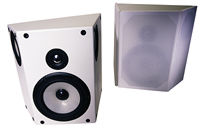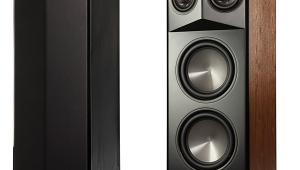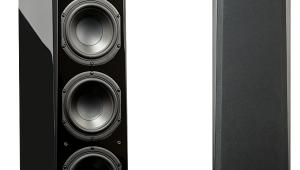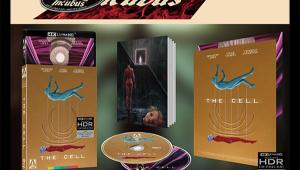Revel Performa F30 surround speaker system Page 3
I've lived with the Revel Performas in my system for four months. I've put on my best reviewer hair shirt and tried to find something wrong with them. Okay, maybe they were a little bright on some material. But so much music and so many movie soundtracks sounded so right—I even preferred the +1 setting on the F30's and C30's level controls for most movies—that the times that they didn't could easily be blamed on the program material. The same could be said for the occasional dialogue coloration. Postproduction dubbing of dialogue is epidemic today, and the sound engineers don't always get it right. The traces of boxiness and nasality I sometimes heard from the C30 on films did not show up on pink noise—the most difficult coloration test of all.
 Perhaps the bass was a little overdone below 30Hz. The post-EQ response curves I ran with the LFO did indicate a substantial rise below 30Hz before the response began to tail off just above 20Hz. We should all be so lucky. You can argue that movie houses typically don't have this much bass. But if you're ever in L.A. when a blockbuster action flick is playing at the single-screen Mann Village theater in Westwood, catch a Friday- or Saturday-night showing, when they have the system cranked for a big crowd. Then try to come back with the same argument. The sound of the B15 subwoofer reminds me of that experience, with one difference: The B15 produces similarly awesome bass, but with a tightness and detail that even audiophiles who take a pass on the bottom octave will appreciate. The subwoofer's prodigious output capability is responsible for its raw power and low-end reach, but the parametric equalizers must be given much of the credit for the lack of the bottom-end boom so common to subwoofer setups.
Perhaps the bass was a little overdone below 30Hz. The post-EQ response curves I ran with the LFO did indicate a substantial rise below 30Hz before the response began to tail off just above 20Hz. We should all be so lucky. You can argue that movie houses typically don't have this much bass. But if you're ever in L.A. when a blockbuster action flick is playing at the single-screen Mann Village theater in Westwood, catch a Friday- or Saturday-night showing, when they have the system cranked for a big crowd. Then try to come back with the same argument. The sound of the B15 subwoofer reminds me of that experience, with one difference: The B15 produces similarly awesome bass, but with a tightness and detail that even audiophiles who take a pass on the bottom octave will appreciate. The subwoofer's prodigious output capability is responsible for its raw power and low-end reach, but the parametric equalizers must be given much of the credit for the lack of the bottom-end boom so common to subwoofer setups.
It will tell you more than I could possibly squeeze into this article when I mention that the final sound-quality evaluations of the DVDs listed in “2001: A DVD Odyssey" (July/August 2001) were made using the Revel Performa system. The bass in Titan A.E. and U-571 was vividly spectacular—over-the-top, certainly, but totally appropriate to the films. I also heard deep bass on Fight Club that I hadn't known was there. And the dynamic range that the Performas produced from these soundtracks was intense. The same could be said for The Lost World: Jurassic Park; the T.rex's growl was as terrifying as it's ever been, despite my having heard it hundreds of times in dozens of JP movies. (What? There are only three?)
The brightness I occasionally heard appeared most often in animated films. Yet although Dinosaur, Toy Story 2, Fantasia 2000, and The Road to El Dorado had this problem to one extent or another through the Revels, that didn't keep them from sounding spectacular anyway. El Dorado was a case in point. On the Dolby Digital track (which sounds a little less rich but more airy than the DTS), delicate details were superbly rendered. Elton John's songs, while hardly his best work, were clean and naturally full-bodied, marred only by a little too much sibilance (a common flaw in pop recordings). And the final escape sequence (chapters 24 and 25) had it all: an exciting, well-recorded score, dynamic effects, and alarmingly intense bass.
But you don't need to be a fan of action epics—live or animated—to appreciate the Revels. The delights of such stunning but often subtle soundtracks as Snow Falling on Cedars, The Green Mile, High Fidelity, and The Cotton Club came through clear—but loud only on the rare scene where high output was called for.
I wrapped up my long-term listening to the Revels by revisiting two films with superb but very different soundtracks, one of which, Air Force One, had been on my shelf, unwatched, for three years. Now I wonder why I hadn't pulled it out more often. Apart from a little brightness (which keeps its sound-quality rating at A rather than A+), the sound is spectacular. Through the Revels, the brightness was evident but never annoying, even with THX re-EQ turned off (which is how I did most of my critical listening). The jet flyovers had an edgy, raucous quality, but who expects jet engines to sound sweet? The bass shook the floor. The gunshots were appropriately punchy yet never made me dive for the level control. The dynamic range on this film is enormous, and the Revels took it in stride at full THX reference level—and even slightly above. And with the Performas, Jerry Goldsmith's rousing (though repetitive) score, if less natural-sounding than the best audio recordings, nevertheless made a crisp and rousing contribution to the film's emotional punch. When it's all over, your head tells you that Air Force One is a just a summer movie, but your gut tells you to start printing harrison ford for president bumper stickers. Such is the scary power of intense drama, vivid images, and stunning sound.
While I wasn't moved to campaign for Nathan Lane after revisiting The Mouse Hunt, the Revels clearly demonstrated the audiophile quality of the film's soundtrack (I listened to the Dolby Digital version). Mouse Hunt may not sound as spectacular as some DVDs, but it has a sense of balance—a canny juggling of clarity and smoothness, dynamic range, depth, and sonic weight—that is irresistible. Of the hundreds of soundtracks I've heard, this may well be the absolute all-time best in everything but the deepest bass. It's certainly in the top five.
Through the Revel Performas, it all came together. It's hard to pick a high point—the organ opening chapter 1, the many thunderstorms early on, the scene in the attic in chapter 5, the mouse in the wall in chapter 7 (including the frightening nail-gun sequence), the city pound in chapter 8 with cats heard everywhere. It's all great, and the Performas provided the wide dynamic range, superbly powerful yet tight bass, good if occasionally somewhat boxy dialogue (a coloration originating in the soundtrack), and open, spacious highs.
I still had Revel's Ultima Gems (L/R) and Voice (center) on hand, but a direct comparison with the Performa system proved difficult. When I performed a simple replacement of the front three speakers, retaining the S30 surrounds and B15 subwoofers, the Ultimas sounded more full-bodied but also more veiled and colored than the Performa F30s and C30! The Ultimas' top end sounded softer, their low treble brighter, and their the mid and upper bass a bit more woolly and less open. The problems appeared to stem largely from blending with the B15 subwoofer—remember, the sub had been balanced and equalized to work properly with the Performas. It was at this point that I got my first real experience with the Revel Low Frequency Optimizer (see LFO sidebar).
- Log in or register to post comments





























































